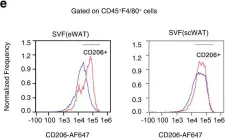Following chronic injury, the adult mammalian bile duct regenerates by forming new branches, essentially replumbing the ductular system to overcome blockages and breaks. To regenerate effectively, biliary epithelial cells (BECs) receive a range of pro-mitogenic signals from myofibroblasts, which concurrently deposit a collagen-rich scar around the duct as it regrows. Despite epithelial regeneration and scarring occurring side-by-side, whether the deposition of scar tissue regulates ductular regeneration per se remains unclear. By inducing ductular fibrosis and regeneration in vivo, we show that the formation of collagen-I-rich scars around regenerating ducts changes the local biomechanical properties of these tissues, promoting the growth of ducts. Critically, this changing structural landscape is perceived by a spatially restricted population of biliary epithelial cells which forms a leading-tip of integrin-alpha2-high cells. This leading-tip undergoes partial-EMT-type reprogramming, allowing it to become migratory and coordinate ductular regeneration. We show that this process is directly driven through an integrin-alpha2-SRC/FAK signalling axis; thereby connecting epithelial regeneration directly to the changing fibrotic environment in chronic ductular disease.
Product Citations: 164
Preprint on BioRxiv : the Preprint Server for Biology on 22 April 2025 by Walker, A., Olaizola, P., et al.
In IScience on 18 April 2025 by Vasquez, J. H., Yuan, J., et al.
MIWI2, a P element-induced wimpy testes (PIWI) argonaute protein known for suppressing retrotransposons during male gonadogenesis, has an unexplored role in mammalian somatic cells. We identify MIWI2 multiciliated (M2MC) cells as a rare subset of airway multiciliated cells and investigate MIWI2's function in antiviral host defense. We analyzed transcriptomes from Miwi2 heterozygous (Miwi2 +/tom) and deficient (Miwi2 tom/tom) mice following influenza A infection. During infection, Miwi2 deficiency was associated with reduced mitochondrial and ribosomal gene expression in M2MC cells, increased mitochondrial reactive oxygen species (ROS) production and ADP/ATP ratios in multiciliated cells, and enhanced viral clearance and recovery. Additionally, Miwi2-expressing cells exhibited reduced levels of small RNAs derived from nuclear mitochondrial DNA. These findings reveal a previously unrecognized role for Miwi2 in regulating small non-coding RNAs and mitochondrial oxidant production in somatic cells, indicating a function beyond its established germline activities. Our study identifies Miwi2/Piwil4 as a potential factor influencing susceptibility to severe respiratory infections.
© 2025 The Author(s).
-
Cell Biology
In STAR Protocols on 21 March 2025 by Kim, U. & Chakrabarti, R.
Neutral lipids affect the immunosuppressive function of myeloid-derived suppressor cells (MDSCs). Here, we present a protocol for measuring neutral lipids in MDSCs using BODIPY from mouse mammary tumor derived from triple-negative breast cancer cells, 4T1, which is applicable to other mammary tumors of interest. We describe steps for 4T1 cell culture, single-cell isolation from tumors, staining of cells with antibodies and BODIPY, and flow cytometry. Furthermore, we introduce alternative protocols with MDSC sorting to overcome risk of cell death by BODIPY. For complete details on the use and execution of this protocol, please refer to Kim et al.1.
Copyright © 2024 The Authors. Published by Elsevier Inc. All rights reserved.
-
Cancer Research
In NPJ Vaccines on 20 March 2025 by Garde, C., Pavlidis, M. A., et al.
Personalized cancer vaccines (PCVs) largely leverage neoantigens arising from somatic mutations, limiting their application to patients with relatively high tumor mutational burden (TMB). This underscores the need for alternative antigens to design PCVs for low TMB cancers. To this end, we substantiate endogenous retroviral elements (EVEs) as tumor antigens through large-scale genomic analyses of healthy tissues and solid cancers. These analyses revealed that the breadth of EVE expression in tumors stratify checkpoint inhibitor-treated melanoma patients into groups with differential overall and progression-free survival. To enable the design of PCVs containing EVE-derived epitopes with therapeutic potential, we developed a computational pipeline, ObsERV. We show that EVE-derived peptides are presented as epitopes on tumors and can be predicted by ObsERV. Preclinical testing of ObsERV demonstrates induction of sustained poly-functional CD4+ and CD8+ T-cell responses as well as long-term tumor protection. As such, EVEs may facilitate and improve PCVs, especially for low-TMB patients.
© 2025. The Author(s).
-
Cancer Research
-
Immunology and Microbiology
Molecular control of PDPNhi macrophage subset induction by ADAP as a host defense in sepsis.
In JCI Insight on 4 February 2025 by Zhang, P., Wang, X., et al.
Induction of podoplanin (PDPN) expression is a critical response of macrophages to LPS stimulation or bacterial infection in sepsis, but how this key process of TLR4-stimulated PDPN upregulation is regulated and the effect of PDPN expression on macrophage function remain elusive. Here, we determined how this process is regulated in vitro and in vivo. PDPN failed to be upregulated in TLR4-stimulated macrophages deficient in adhesion and degranulation-promoting adapter protein (ADAP), which could be rescued by the reconstitution of ADAP. A distinct PDPNhi peritoneal macrophage (PM) subset, which exhibited an M2-like phenotype and enhanced phagocytic activity, was generated in WT but not in ADAP-deficient septic mice. The blockade of PDPNhi PMs mimicked the effect of ADAP deficiency, which exacerbated sepsis. Mechanistically, Bruton's tyrosine kinase-mediated (BTK-mediated) tyrosine phosphorylation of ADAP at Y571 worked together with mTOR to converge on STAT3 activation for the transactivation of the PDPN promoter. Moreover, agonist activation of STAT3 profoundly potentiated the PDPNhi PM subset generation and alleviated sepsis severity in mice. Together, our findings reveal a mechanism whereby ADAP resets macrophage function by controlling the TLR4-induced upregulation of PDPN as a host innate immune defense during sepsis.
-
Mus musculus (House mouse)
-
Immunology and Microbiology
In Nat Commun on 25 November 2022 by Yan, J., Zhang, Y., et al.
Fig.3.E

-
FC/FACS
-
Mus musculus (House mouse)
Collected and cropped from Nat Commun by CiteAb, provided under a CC-BY license
Image 1 of 1
